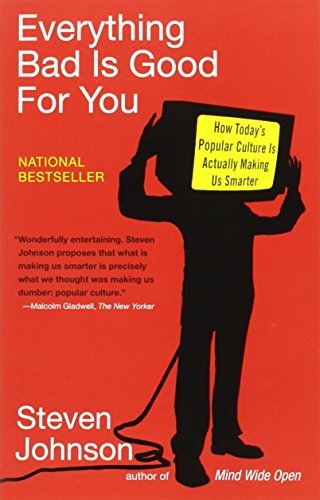Everything Bad is Good for You
İngilizce
Psikoloji
Tune in, turn on and get smarter ...
The Simpsons, Desperate Housewives, The Apprentice, The Sopranos, Grand Theft Auto: We're constantly being told that popular culture is just mindless entertainment. But, as Steven Johnson shows, it's actually making us more intelligent.
Here he puts forward a radical alternative to the endless complaints about reality TV, throwaway movies and violent video games. He shows that mass culture is actually more sophisticated and challenging than ever before. When we focus on what our minds have to do to process its complex, multilayered messages, it becomes clear that it's not dumbing us down - but smartening us up.
Yazar
: Steven JohnsonYayınevi
: Penguen Yayınevi
ÖZET
- The entertainment industry has pushed the content envelope too far; television and films filled with sex, violence and profanity send strong negative messages to the youth of America – messages that will desensitize them and make for a far more disenfranchised society as these youths grow into adults.
- People who read for pleasure are many times more likely than those who don’t to visit museums and attend musical performances, almost three times as likely to perform volunteer and charity work, and almost twice as likely to attend sporting events.
Readers, in other words, are active, while nonreaders – more than half the population- have settled into apathy.
There is a basic social divide between those for whom life is an accrual of fresh experience and knowledge, and those for whom maturity is a process of mental atrophy.
- What are the rewards of reading, exactly?
They fall into two categories:- The information conveyed by the book, and
- The mental work you have to do to process and store that information.
- Reading requires effort, concentration, and attention.
It offers the stimulus to and the fruit of thought and feeling.
Reading is an activity requiring active participation.
The mental benefits of reading also invoke the power of imagination; reading books forces you to concoct entire worlds in your head, rather than simply ingest a series of prepackaged images.
- To summarize, the cognitive benefits of reading involve these faculties: effort, concentration, attention, the ability to make sense of words, to follow narrative threads, to sculpt imagined worlds out of mere sentences on the page.
- Playing video games may not actually be a complete waste of time.
Minor side effect of game-playing – often manual dexterity or visual memory – heavy gamers show improved skills compared to non-gamers.
Playing today’s games does in fact improve your visual intelligence and your manual dexterity, but the virtues of gaming run far deeper than hand-eye coordination.
- THE DIRTY little secret of gaming is how much time you spend not having fun.
Anyone who has spent more than a few hours trying to complete a game knows the feeling: you get to a point where there’s a sequence of tasks you know you have to complete to proceed further into the world, but the tasks themselves are more like chores than entertainment, something you have to do, not something you want to do: building roads and laying power lines, retreating through a tunnel sequence to find an object you’ve left behind, conversing with characters when you’ve already memorized their lines.
- My nephew would be asleep in five seconds if you popped him down in an urban studies classroom, but somehow an hour of playing SimCity taught him that high tax rates in industrial areas can stifle development.
- Most of the time, when you’re hooked on a game, that draws you in is an elemental form of desire: to desire to see the next thing.
- If you create a system where rewards are both clearly defined and achieved by exploring an environment, you’ll find human brains drawn to those systems, even if they’re made up of virtual characters and simulated sidewalks.
- It’s not what you’re thinking about when you’re playing a game, it’s the way you’re thinking that matters.
- Far more than books or movies or music, games force you to make decisions.
Novels may activate our imagination, and music may conjure up powerful emotions, but games force you to decide, to choose, to prioritize.
Learning how to think is ultimately about learning to market the right decisions: weighing evidence, analyzing situations, consulting your long-term goals, and then deciding.
- Word problems have little to offer in the way of moral lessons or psychological depth; they won’t make students more effective communicators or teach them technical skills.
But they are good for the mind on some fundamental level: they teach abstract skills in probability, in pattern recognition, in understanding casual relations that can be applied in countless situations, both personal and professional.
- What you actually do in playing a game. Is not about tolerating or aestheticizing chaos; it’s about finding order and meaning in the world, and making decisions that help create that order.
- Like those video games that force you to learn the rules while playing, part of the pleasure in modern television narratives comes from the cognitive labor you’re forced to do filling in the details.
- The sitcom genre as a whole has wilted in the past few years, as television execs turned their focus to the new – and oft-abused – ratings champ: reality programming.
- Many reality shows borrow a subtler device from gaming culture as well: the roles aren’t fully established at the outset.
You learn as you play.
- Reality programming borrowed another key ingredient from games: the intellectual labor of probing the system’s rules for weak spots and
As each show discloses its conventions, and each participant reveals his or her personality traits and background, the intrigue in watching comes from figuring out how the participants should best navigate the environment that’s been created for them.
The pleasure in these shows comes not from watching other human beings humiliated on national television; it comes from depositing other human beings in a complex, high stakes environment where no established strategies exist, and watching them find their bearings.
- Human express the full complexity of their emotions through the unspoken language of facial expressions, and we know from neuroscience that parsing that language – in all of its subtlety – is one of the greatest accomplishments of the human brain.
One measure of this intelligence is called AQ, short for “autism quotient.”
People with low AQ scores are particularly talented at reading emotional cues, anticipating the inner thoughts and feelings of other people, a skill that is sometimes called mind reading.
(Autistic people suffer from a diminished capacity for reading the language of facial expressions, which is why a high AQ score implies worse mind reading skills.)
- Reality shows, challenge our emotional intelligence and our AQ.
They are elaborately staged group psychology experiments, where at the end of the sessions the subjects get a million dollars and a week on the cover of People instead of a fifty-dollar stipend.
- Part of that collateral learning comes from the sheer number of characters involved in a show.
The reality shows demand that we track multiple relationships, since the action of these shows revolves around the shifting feuds and alliances between more than a dozen individuals.
This, too, activates a component of our emotional IQ, sometimes called our social intelligence: our ability to monitor and recall many distinct vectors of interaction in the population around us, to remember that Peter hates Paul, but Paul likes Peter, and both of them get along with Mary.
- Like many forms of emotional intelligence, the ability to analyze and recall the full range of social relationships in a large group is just is reliable a predictor of Professional success as your SAT scores or your collage grades.
- Reality shows force us to exercise that social muscle in ways that would have been unimaginable on past game shows, where the primary cognitive skill tested was the ability to correctly guess the price of a home appliance, or figure out the right time to buy a vowel.
- Popular audiences embraced television and the cinema in comparable time frames, but neither required the learning curve of e-mail or the Web.
It’s one thing to adapt your lifestyle to include time for sitting around watching a moving image on a screen; it’s quite another to learn a whole new language of communication and a small army of software tools along with it.
- The rise of the Internet has challenged our minds in three fundamental and related ways: by virtue of being participatory, by forcing users to learn new interfaces, and by creating new channels for social interaction.
- Steve Jobs likes to describe the difference between television and the Web as the difference between lean-back and sit-forward media.
The conventional wisdom is, every now and then, actually wise.
- As a vehicle for narratives and first-person intimacy, television can be a delightful medium, capable of conveying remarkably complex experiences.
But as a source of information, it has its limitations.
The rise of the Web has enabled television to offload some of its information-sharing responsibilities to a platform that was designed specifically for the purposes of sharing information.
- The second way in which the rise of the Net has challenged the mind runs parallel to the evolving rule systems of video games: the accelerating pace of new platforms and software applications forces users to probe and master new environments.
Your mind is engaged by the interactive content of networked media – posting a response to an article online, maintaining three separate IM conversation at the same time – but you’re also exercising cognitive muscles interacting with the form of the media as well: learning the tricks of a new e-mail client, configuring the video chat software properly, getting your bearings after installing a new operating system.
- Television and automobile society locked people up in their living rooms, away from the clash and vitality of public space, but the Net has reserved that long-term trend.
After a half-century of technological isolation, we’re finally learning new ways to connect.
- As narratives cinema evolved as a genre, and as audiences grew comfortable with that evolution, the form grew increasingly adventurous in the cognitive demands it made on its audience – just as television and games have done over the past thirty years.
- THE SLEEPER CURVE charts a trend in the culture: popular entertainment and media growing more complex over time.
- The violent games may generate the most outrage, but the games that people reliably line up to buy are the ones that require the most thinking.
Somehow in this age of attention deficit disorder and instant gratification, in this age of gratuitous violence and cheap titillation, the most intellectually challenging titles are also the most popular.
Games that force us the probe and telescope. Television shows that require the mind to fill in the blanks, or exercise its emotional intelligence. Software that makes us sit forward, not lean back.
- As African – Americans were granted greater access to the educational system, their IQ scores improved accordingly.
- Black scores were rising, to be sure.
But white scores were rising almost as fast.
In forty-six years, the American people had gained 138 IQ points on average.
- Flynn Effect: When you look at a snapshot of black and white IQ tests from 1975, explaining the difference between those score is a necessarily murky affair: each group possesses different combinations of genes and different environments.
But when you look at IQ scores across generations, the Picture gets clearer.
Whatever genetic differences may exist between groups disappear, because you’re looking at the average IQ of the entire society.
The gene pool hasn’t changed in a generation, and yet the scores have gone up.
Some environmental factor (or combination of factors) must be responsible for the increase in the specific forms of intelligence that IQ measures: problem solving, abstract reasoning, pattern recognition, spatial logic.
- IQs have been rising in most developed countries at an extraordinary clip over past century: an average of 3 points per decade. Yesterday’s brainiac is today’s simpleton.
- If we’re not getting these cognitive upgrades from our diets or our classrooms, where are they coming from?
The answer should be self-evident by now.
It’s not the change in our nutritional diet that’s making us smarter, it’s the change in our mental diet. Think of the cognitive labor – and play – that your average ten-year-old would have experienced outside of school a hundred years ago: reading books when they were available, playing with simple toys, improvising neighborhood games like stickball and kick the can, and most of all doing household chores – or even working as a child-laborer.
Compare that to the cultural and technological mastery of a ten-year-old today:
following dozens of professional sports teams; shifting effortlessly from phone to IM to e-mail in communicating with friends; probing and telescoping through immense virtual worlds; adopting and troubleshooting new media Technologies without flinching.
In the world outside of school, their brains challenged at every turn by new forms of media and technology that cultivate sophisticated problem-solving skills.
- When your ten-year-old figures out how to consolidate all seven remote controls into a single unit, she’s exercising problem-solving muscles with an insistence that rivals anything she’s learning at school.
You want your children fixing your home theater setup, not because they’ll be able to use that skill working for Circuit City one day, but rather because there’s a commendable structure to this kind of thinking.
- When you’re mapping the complex relationships of 24 to figure out who the mole is, you’re doing a social network rendition of the Raven grid: looking for patterns of behavior that reveals a hidden identity.
When you’re trying to figure out why your new e-mail client keeps crashing your PC, you’re analyzing an array of potential clues – separating the essential from the peripheral – the figure out the underlying conflict.
In all these activities, you have to analyze a complex tableau, build a working model of it in your head, and then make a decision.
In the most basic sense, these different forms of media reward you for solving something.
- The Sleeper Curve shows that the popular culture is growing more complex, yet it is not sufficiently complex to challenge the most gifted minds, which is why the geniuses aren’t getting any smarter. What has changed is the cognitive workout that mass culture offers the rest of us.
- If environmental factors are responsible for the increase in IQ over the past fifty years.
What has changed in the environment over that time? Media and technology.
- The Sleeper Curve is partly powered by the force of repetition.
Over the past twenty years, a fundamental shift has transformed the economics of popular entertainment: original runs are now less lucrative than repeats.
- Nietzsche’s idea “eternal recurrence”, his alternative model to Christian morality.
Instead of getting people to do the right thing by threatening them with eternal damnation, Nietzsche proposed an alternative structuring myth in which our lives were going to be repeated ad infinitum.
If we made a mistake in this life, we’d keep making it forever, which presumably would end up encouraging us not to make mistakes in the first place.
As a governing principle for creating quality pop culture, eternal recurrence makes a lot of sense. Design each title so that it can be wanted many times, and you’ll end up with more interesting and more challenging culture.
- TECHNOLOGICAL INNOVATION, of course, has contributed mightily to the Sleeper Curve such as tools designed to let you rewind, replay, repeat.
- New recording technologies are often described as technologies of convenience: you watch what you want to watch, when you want to watch it.
- As technologies of repetition allowed new levels of complexity to flourish, the rise of the Internet gave that complexity a new venue where it could be dissected, critiqued, rehashed, and explained.
- The old way to market a new cultural product was to sell it like detergent: get your brand and your message in front of as many people as possible, and hope to persuade some of them to buy the product.
That’s the philosophy of mass marketing, and it may indeed work well for consumer goods where the consumers themselves don’t have a huge emotional investment in the product.
But where culture is concerned – movies, books, television shows – people don’t just built relationships with products based on the dictates of mass advertising.
Word of mouth is often more powerful, and where word of mouth is concerned, some consumers speak louder than others.
They’re the early adopters; the ones who pride themselves on their pop culture mastery, their eye for new shows and rising talent.
- Technology amplifies the Sleeper Curve in one final respect:
it introduces new platforms and genres at an accelerating rate.
- Children zone out in front of their TV shows or their video games because the mind seeks out mindlessness.
This is the Slacker theory of brain function: the human brain desire above all else that the external world refrains from making it do too much work.
A society where maturity is a “process of mental atrophy.”
- The brain has dedicated systems that respond to – and seek out – new challenges and experiences. We are a problem-solving species, and when we confront situations where information needs to be filled in, or where a puzzle needs to be untangled, our minds compulsively ruminate on the problem until we’ve figured it out.
When we encounter novel circumstances, when our environment changes in a surprising way, our brains lock in on the change and try to put it in context or decipher its underlying logic.
- Parents can sometimes be appalled at the hypnotic effect that television has on toddlers;
they see their otherwise vibrant and active children gazing silently, mouth agape at the screen, and they assume the worst: the television is turning their child into a zombie.
The same feeling arrives a few years later, when they see their grade-schoolers navigating through a video game world, oblivious to the reality that surrounds them.
But these expressions are not signs of mental atrophy.
They’re signs of focus.
The toddler’s brain is constantly scouring the world for novel stimuli, precisely because exploring and understanding new things and experiences is what learning is all about.
In a house where most of the objects haven’t moved since yesterday, and no new people have appeared on the scene, the puppet show on the television screen is the most surprising thing in the child’s environment, the stimuli most in need of scrutiny and explanation.
And so the child locks in.
The child’s brain locks into those images for good reason.
- The game are growing more challenging because there’s an economic incentive to make them more challenging – and that economic incentive exists because our brains like to be challenged.
- We’re reading less because there are only so many hours in the day, and we have all these new options to digest and explore.
If reading were the only cultural pursuit to show declining numbers, there might be cause for alarm. But that decline is shared by all the old media forms across the board.
As long as reading books remains part of our cultural diet, and as long as the new popular forms continue to offer their own cognitive rewards, we’re not likely to descend into a culture of mental atrophy anytime soon.
- Thanks to e-mail and the Web, we’re reading text as much as ever, and we’re writing more.
But it is true that a specific, historically crucial kind of reading has grown less common in this society: sitting down with a three-hundred-page book and following its argument or narrative without a great ideal of distraction.
We deal with text now in shorter bursts, following links across the Web, or sifting through a dozen e-mail messages.
The breadth of information is wider in this mail messages.
The breadth of information is wider in this world, and it is far more participatory.
- So the Sleeper Curve suggests that the popular culture is not doing as good a job at training our minds to follow a sustained textual argument or narrative that doesn’t involve genuine interactivity. (As we’ve seen in gaming culture, kids are incredibly talented at focusing for long stretches when the form is truly participatory.)
That kids aren’t being exclusively educated by their Nintendo machines or their cell phones.
We still have schools and parents to teach wisdom that the popular culture fails to impart.
Parents should “foster in [their] children a love of reading and the printed word from the start.”
They just shouldn’t underestimate the virtues of other media as well.
- We’re raising a generation of cognitive superstars who are nonetheless ethically rudderless. Intelligent, yes, but without values.
- Video games have grown dramatically more violent in the past fifteen years, as the graphical capabilities of the modern PC have enabled ever more realistic displays of bloodshed.
- The question is whether that violence has an effect on the mind that apprehends it.
I believe different forms of media can alter our brains in significant ways; the premise of the Sleeper Curve adheres to that principle: more complex popular entertainment is creating minds that are more adept at certain kinds of problem-solving.
But violence is part of the content of popular media, and the content of most entertainment has less of an impact than the kind of thinking the entertainment forces you to do.
This is why we urge parents to instill a general love of reading in their children, without worrying as much about what they’re reading – because we believe there is a laudable cognitive benefit that comes just from the act of reading alone to television or film or games.
- By any measure, the content of a 24 episode is more violent and disturbing than an episode of My Three Sons.
But 24 makes the viewer think in ways that earlier shows never dared; it makes them analyze complex situations, track social networks, fill in information withheld by the creators.
The violence they encounter on these contemporary shows is fiction; we should not look to Tony Soprano for moral guidance, or model their real-world driving on their Grand Theft Auto But the mental exercise undergo in watching these shows or playing these games is not fiction.
- If there is some positive correlation between exposure to fictional violence and violent behavior, its effects are by definition much weaker than the other social trends that shape violence in society.
- Yes, the trends are toward more media complexity; yes, games and television shows and films have cognitive rewards that we should better understand and value.
But some of those cultural works are more rewarding than others. - I am not arguing that parents and other caregivers should stop paying attention to the way their children amuse themselves.
What I am arguing for is a change in the criteria we use to determine what really is cognitive junk food, and what is genuinely nourishing.
Instead of worrying about a show’s violent or tawdry content, instead of agitating over wardrobe malfunctions or the f-word, the true test should be whether a given show engages or sedates the mind.
If your kids want to watch reality TV, encourage them to watch Survivor over Fear
If they want to watch a mystery show, encourage 24 over Law & Order.
If they want to play a violent game, then encourage Grand Theft Auto over Quake.
For parents, if your selection principle is built around cognitive challenge, and not content, then you needn’t limit your children’s media intake to dutiful nightly exposure to Jim Lehrer and NOVA; the popular culture is supplying plenty of vigorous cognitive workouts on its own.
- The kids are forced to think like grownups:
analyzing complex social networks, managing resources, tracking subtle narrative intertwining, recognizing long-term patterns.
The grownups, in turn, get to learn from the kids: decoding each new technological wave, parsing the interfaces, and discovering the intellectual rewards of play.
Parents should see this as an opportunity, not a crisis.
Smart culture is no longer something you force your kids to ingest, like green vegetables.
It’s something you share.
- Sleeper Curve does not mean that teachers or parents or role models have become obsolete.
It does not mean that we should give up on reading and let our kids spend all their free time tethered to the Xbox.
But it does mean that we should discard, once and for all, a number of easy assumptions we like to make about the state of modern society.
The cultural race to the bottom is a myth; we do not live in a fallen state of cheap pleasures that pale beside the intellectual riches of yesterday.
And we are not innate slackers, drawn inexorably to the least offensive and least complicated entertainment available.
All around us the world of mass entertainment grows more demanding and sophisticated, and our brains happily gravitate to that newfound complexity.
- Yes, popular culture can be addictive and time-consuming; yes, you have to draw the line sometimes.
The same is true of social interaction, as any parent of a teenager will tell you.
But you can’t figure out where to draw the line if you don’t have a working theory of the potential benefits.
To plan a balanced diet, you need to know something about the nutrients in all the food groups, non-just the ones that have tradition on their side.
- “Researchers at the University of Rochester found that young adults who regularly played video games full of high-speed car chases and blazing gun battles showed better visual skills than those who did not.
They kept better track of objects appearing simultaneously and processed fast-changing visual information more efficiently.”






